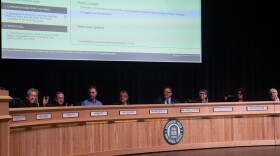Several wildfires burning throughout California have forced people from their homes. They've burned tens of thousands of acres in Santa Barbara, Santa Cruz and Shasta Counties. Earlier this week, we spoke with Lieutenant Colonel David Condit. He's program manager for the Air Force Reserve aerial firefighting program.
Dwane Brown: You guys recently received funding for more aerial support, can you tell us a little more about that and how that’s going to work out.
Lieutenant Colonel David Condit: Yeah, we’ve had a program that’s evolved over the last several years to give us some new equipment which we’ve taken delivery of this year. Two of those systems are currently in Southern California and ready to fight on the fires if the California Department of Forestry needs them.
Brown: Budget cuts in San Diego and California mean less money for aerial support to fight wildfires. What role do you see the military playing?
Condit: We tend to back up the federal agencies, so if CAL FIRE needs us they’ll request us through the national fire center, and typically that’ll be funded using federal dollars rather than state dollars.
Brown: Now, much was said about the lack of coordination during the 2003 and 2007 wildfires here in San Diego county. How do you work with those state and local fire departments to actually improve the effort?
Condit: I think any time you have a situation like 2003 we try to capture the lessons from that and translate them to new procedures and tactics for the following years. So that’s what we did in 2003. We learned some great lessons and what we did this year is we worked with folks from CAL FIRE and the US Forest Service and several other agencies and had a big exercise at the beginning of summer so we could make sure we were ready to fight those fires if the need arose.
Brown: Does your preparation change from season to season?
Condit: Not really. I think what we do is we take the lessons we learn and we add them to what we’ve already known, and we make small adaptations based on the way things are moving. For the most part we have a pretty solid training program and a pretty solid preparation program that looks about the same each year.
Brown: Give us an idea of what we’re talking about when we say state-of-the-art aerial firefighting equipment.
Condit: Our old systems consist primarily of World War II and Korean War era bombers, and so this new system is designed to slide into the back of newer aircraft like our military C-130s. So that system has built on the technology and the lessons we’ve learned over many decades of fighting fires. So this system is more capable; it can put more retardant onto a fire in a quicker amount of time at a lower cost.
Brown: And what have you learned from fighting fires, say, in other countries, that you can bring to bear here?
Condit: I think any time you see the way another country works and how their, especially how their agencies work together, there’re lessons to go both directions. So, I think we bring something to them that they can learn, and they bring something to us any time we look at those agencies interact. We like to bring those things back, whether it’s working with a state or federal agency to translate the things that we’ve learned abroad into how we can operate here in our own country.







